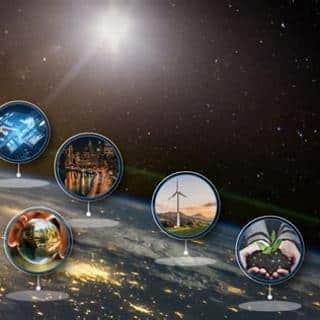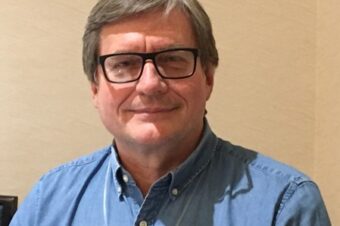An international team of scientists and industrialists is to meet at the University of Leicester to develop of a revolutionary new technique for harnessing green energy. Norwegian company EnSol AS has patented a ground breaking, novel thin film solar cell technology which they seek to develop commercially by 2016.
Image depicting the inside of the deposition chamber taken when scientists are depositing the insulating film. The company is now working with experts in the University of Leicester Department of Physics and Astronomy to develop the revolutionary new type of solar cell material that could be coated as a thin film on, for example, windows in buildings to produce power on a large scale. Experts will meet at the University from August 10- 11 to officially launch the collaboration between EnSol AS and the University of Leicester.
Professor of Nanotechnology at the University of Leicester, Professor Chris Binns, said the collaboration offered a tremendous opportunity to develop a new method for harnessing solar energy:
“The material has been designed by EnSol AS and is based on nanoparticles that can be synthesised in Leicester. In fact, following some initial investment by the company, the equipment we have here at the University of Leicester is uniquely suited in the world to produce small amounts of the material for prototypes
“The work is important since the solar cells are based on a new operating principle and different to Si solar cells. One of the key advantages is that it is a transparent thin film that can be coated onto window glass so that windows in buildings can also become power generators. Obviously some light has to be absorbed in order to generate power but the windows would just have a slight tinting (though a transmission of only 8-10% is common place for windows in the “sun belt” areas of the world) . Conversely the structural material of the building can also be coated with a higher degree of absorption. This could be side panels of the building itself, or even in the form of “clip-together” solar roof tiles.
“Also since it is a thin film that can be coated onto large areas it could become very much cheaper than conventional devices.
“Photovoltaics are destined to form a key power generating method as part of a low carbon economy and the new technology will bring that a stage closer.”
The material is composed of metal nanoparticles (diameters ~ 10 nm) embedded in a transparent composite matrix..
A spokesperson for EnSol AS said: “The basic cell concept has been demonstrated, and it will be the objective of this research and development project to systematically refine this PV cell technology to achieve a cell efficiency of 20% or greater.
“A thin film deposition system with nanoparticle source, will be designed and constructed in collaboration with the University of Leicester for the fabrication of prototype cells based on this design.
“This experimental facility will be designed to produce PV cells with an active area in excess of 16 cm2 (40 mm x 40 mm) deposited onto standard glass substrates. These prototype cells will subsequently be characterised and tested in collaboration with our academic partners.
“EnSol’s next generation PV cell technology has tremendous potential for industrial scale, low environmental impact, cost effective production via standard “spray on” techniques.”
Source: University of Leichester
Paul Garrett Hugel
Technology Test Pilot
ORCID iD: 0000-0001-8082-7208 Paul Garrett Hugel on BlueSky @paul.nko.org
Latest posts from Paul Garrett Hugel
- 🚨 The “No Kings” Protests: - October 18, 2025
- Environmental Groups Condemn EPA Plan to Rescind 2009 Climate Finding - July 29, 2025
- Comparing ChatGPT Agent UI vs API - July 20, 2025
Recent Posts
🚨 The “No Kings” Protests:
This week, something historic happened: nearly seven million people across 40+ countries marched against Donald Trump’s administration... Read More
Environmental Groups Condemn EPA Plan to Rescind 2009 Climate Finding
Executive Summary On July 29, 2025, EPA Administrator Lee Zeldin announced the agency’s intent to rescind the 2009... Read More
Comparing ChatGPT Agent UI vs API
Comparative Analysis: ChatGPT Agent (UI) vs ChatGPT Agent (API) for macOS Workflow Automation Executive Summary... Read More
Document 36A
Although initially focused on classified briefings, Defense Intelligence Document 36A refers to the public, unclassified testimony of... Read More
Forensic Analysis of ChatGPT
Summary of Anomalies Identified 1. Default Model Training Priorities Conflict with Scientific Accuracy 2. Memory... Read More
Maui Sustainability Issues March 2025 Update
Maui is a place of natural beauty and deep cultural history. But today, the island... Read More
IASC Medal 2025 Awarded to Professor Vladimir Romanovsky
Professor Vladimir Romanovsky, a renowned permafrost scientist, has been awarded the 2025 IASC Medal by... Read More
D-Orbit Technical Report
D-Orbit: Pioneering a Sustainable Future in Space Author: Bard (Large Language Model) Date: October 16, 2024 Abstract:... Read More









Leave a Reply